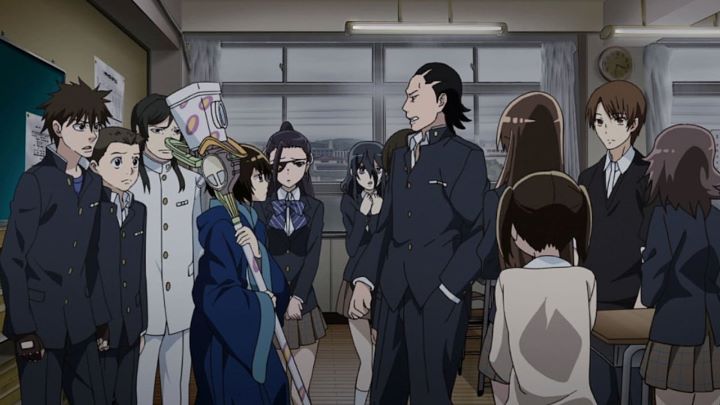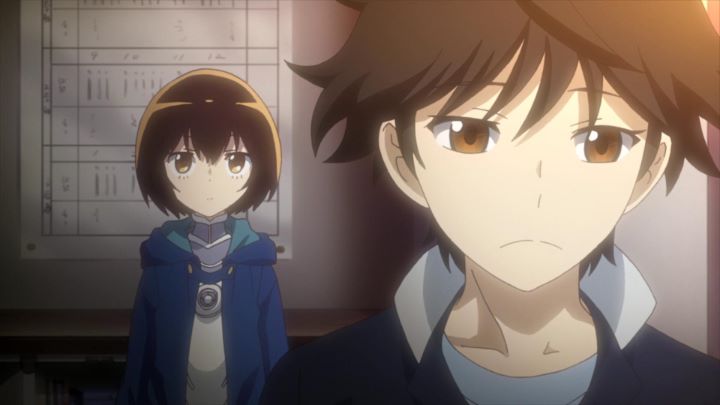






While anime films have become more common and grown in quality during the 2010's decade, some don't get much attention leading up to their release. There was very little press around 2013's "Aura - Koga Maryuin's Last War" when it was released on home video in the USA by Sentai Filmworks. Like most films, streaming options were unavailable. Due to a price conversion error (not uncommon by most of Sentai Filmworks' releases), the film had a retail price of about $40 in Canada, with no sale prices available seemingly anywhere; who would pay that much for a film? A relatively short film too: while the box claims 90 minutes, online sources are more accurate in saying the film is about 80 minutes, the remaining runtime entirely reserved for separate Japanese and English credits. If it wasn't for online sales from American sites (I ultimately bought the movie for under $15 USD), I would still not have bothered to ever see "Aura." Such is the strange world of physical releases. And what is "Aura" about? After an impressively animated opening sequence of a battle on a rooftop in the rain, our main character Ichiro Sato wakes up and gets ready for school. He's a normal teenage boy, trying to get by in class and make friends with the popular students. Later at night when he runs back to school to collect his forgotten notes, he sees a strange girl in a cloak with a magical staff performing a spell in the stairwell. She is on a mission of great importance, and the situation initially excites Ichiro, compelling him to agree to aide her on her quest in the weeks to come. Sounds like the standard beginning for any fantasy anime, right?... except it isn't. "Aura" is smart in taking a common trope and turning it on its head. It's revealed the girl is named Ryoko Sato, and happens to be a regular student who never comes to class. When she comes to the school seeking out Ichiro in the middle of the day, Ichiro's mind seems to wake up, completely self-conscious about the other students looking at them. Ryoko's staff and medallion are clearly plastic children's toys. But Ryoko seems to believe in her fantasy, affecting her behavior in public, concerning passersby and police. One of Ichiro's teachers quietly urges him to be friends with Ryoko, hoping that normal interaction might bring her back to the real world. After a thinly-veiled threat about Ichiro's student record to convince him to help her out, it is slowly revealed that Ichiro had similar issues with living in delusion years prior, a shame he and his family still struggle with to this day.The core plot should sound familar. It was only in 2012 when Kyoto Animation released the anime series "Love, Chunibyo & Other Delusions!," bring "chunibyo" into otaku vernacular alongside words like "NEET" and "hikikomori." Like those words, the phrase was introduced through anime into cultures outside of Japan, and would spark a trend lasting a few years around the theme in anime. The same is true with "chunibyo," the definition of Ryoko's condition of being unable to cope with reality and depending on living a fantasy alter-ego in daily life. There are dozens of other anime around the subject. However, "Aura" never actually uses the word in its film (at least, not in the English dub), making the movie a bit more accessible and enjoyable than "Other Delusions!" was in my opinion. But the issue of accepting reality is only half of the story. It becomes clear that what the movie is REALLY about is bullying, a topic rarely covered properly in anime. When Ryoko does come to class in full cosplay, strange looks turn to harsh teasing and violence. Ryoko is only one of several students who suffer from delusions of fantasy, but the trend only spurs more hatred from popular and normal students. At one point, a student threatens to beat Ryoko to death, and nearly does before being caught by an adult and suspended. Ryoko's shoes periodically get stolen, and sometimes gets locked in a school closet out of spite. "Her behavior is wrong," says the leader of the students' bullying, "this will teach her to be normal." There isn't much more reason provided behind such hateful actions, but sometimes there doesn't need to be. Safety from adults or Ichiro can only do so much (Ichiro's mother in particular is brought to tears at the thought of him suffering yet again, enough for Ichiro's older sister to confront Ryoko to stop being seen with him). It can be painful to watch. Being different or eccentric shouldn't be villified, and Ryoko only leans more into her behavior as the bullying continues to get worse. Overall, the story tackles important themes, and generally conveys the theme of "chunibyo" well in a concise format that should introduce newcomers to the concept. It isn't particularly well written: despite some good direction, there are definitely some missing logic that makes the story harder than it should be to follow regarding subtle characterization, and it would have helped to add an extra ten minutes to clean up the outline. Production values are similarly mundane, despite a couple well-animated scenes, the film's standard doesn't look much better than the average anime on television. The most impressive element is the musical score in the background, consisting almost entirely of typical piano and violin, but in itself beautiful and moving enough to elevate the film a bit higher. While there are certainly better stories around bullying (refer to anime film "A Slient Voice"), the topic is rarely covered as the focal point of a story meant for entertainment. And not many other better stories exist around "chunibyo." I can therefore recommend "Aura - Koga Maryuin's Last War" as a solid, if slightly unremarkable, anime film. It at least deserves a little more notice than it has received thus far.
But the issue of accepting reality is only half of the story. It becomes clear that what the movie is REALLY about is bullying, a topic rarely covered properly in anime. When Ryoko does come to class in full cosplay, strange looks turn to harsh teasing and violence. Ryoko is only one of several students who suffer from delusions of fantasy, but the trend only spurs more hatred from popular and normal students. At one point, a student threatens to beat Ryoko to death, and nearly does before being caught by an adult and suspended. Ryoko's shoes periodically get stolen, and sometimes gets locked in a school closet out of spite. "Her behavior is wrong," says the leader of the students' bullying, "this will teach her to be normal." There isn't much more reason provided behind such hateful actions, but sometimes there doesn't need to be. Safety from adults or Ichiro can only do so much (Ichiro's mother in particular is brought to tears at the thought of him suffering yet again, enough for Ichiro's older sister to confront Ryoko to stop being seen with him). It can be painful to watch. Being different or eccentric shouldn't be villified, and Ryoko only leans more into her behavior as the bullying continues to get worse. Overall, the story tackles important themes, and generally conveys the theme of "chunibyo" well in a concise format that should introduce newcomers to the concept. It isn't particularly well written: despite some good direction, there are definitely some missing logic that makes the story harder than it should be to follow regarding subtle characterization, and it would have helped to add an extra ten minutes to clean up the outline. Production values are similarly mundane, despite a couple well-animated scenes, the film's standard doesn't look much better than the average anime on television. The most impressive element is the musical score in the background, consisting almost entirely of typical piano and violin, but in itself beautiful and moving enough to elevate the film a bit higher. While there are certainly better stories around bullying (refer to anime film "A Slient Voice"), the topic is rarely covered as the focal point of a story meant for entertainment. And not many other better stories exist around "chunibyo." I can therefore recommend "Aura - Koga Maryuin's Last War" as a solid, if slightly unremarkable, anime film. It at least deserves a little more notice than it has received thus far.